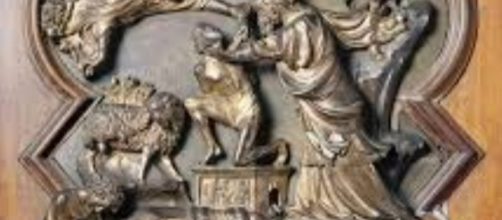“Toto, I have the feeling we’re not in Kansas anymore.” So said Dorothy to her dog in the ‘39 musical fantasy “Wizard of Oz.” Those words could also speak for anyone who sees the 17-foot-tall bronze cast of Lorenzo Ghiberti’s gilded doors “Gates of Paradise” in the entrance hall of the Nelson-Atkins Museum of Art in Kansas City. The actual doors from the 15th century form the entry to the baptistery of the Florence Cathedral.
The Renaissance connection
The bronze cast - 10 panels of bas reliefs illustrating Old Testament stories – a gift from Paul DeBruce and his wife, Linda Woodsmall-DeBruce - begs the question, what do Ghiberti’s “Gates of Paradise” have to do with the Kansas City museum?
Director Julián Zugazagoitia sees them as a doorway to appreciating the treasure house’s other Renaissance collection. Of course, that can be said of any art institution that holds 15th century work. Someone should at least mention that one of the panels – a description of Abraham’s near-sacrifice of Isaac - lays a claim to fame all by itself.
Beating the competition
It was the way Ghiberti pictured the Abraham And Isaac scene that won him the commission for the cathedral doors and gave him a victory over master sculptor Filippo Bruneleschi’s bas relief on the same subject. Historical records show that the judges for the competition admired the way Ghiberti unified his figures and how the angel soaring overhead creates the illusion of a third dimension.
Giorgio Vasari, historian at the time, saw Ghiberti’s vision of this Biblical story as so persuasive that it looks “breathed into” rather than labored over with iron tools.
Two versions of a Bible verse
Another winning feature in this sculpture of the Abraham and Isaac story: it was less violent than Brunelleschi’s. Instead of picturing a father towering over his son from the rear and holding him by the chin, as if to better expose his neck for the axe, you see the boy held only by the shoulder as both figures face one another.
And while Brunelleschi has Abraham drive his knife forward so forcefully that an angel had to grab his wrists to stop him, Ghiberti’s scene is gentle. There’s no need to stay his hand. The angel’s word was enough.
Say it with feeling
There were seven other artists in the competition for these cathedral doors, each illustrating Biblical events.
But the quality of Ghiberti’s work – the complexity of his compositions and the feelings he endowed his figure art with - are marked and very Renaissance. And talk about complex composition, another of his panel titled “Joseph Sold Into Slavery” is like some scene out of a Cecile B. DeMille cast-of-thousands extravaganza, complete with animals and even a grand temple, all of which moved Michelangelo to swoon over Ghibert’s Baptistery doors, “They are so beautiful that they would grace the entrance to Paradise,’” which is how the doors got their name: The Gates of Paradise.


